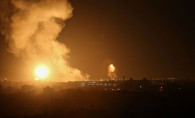Palestinian Environmental NGOs Network to Jusoor Post: Israel annihilates not only humans but also environment
Palestinian Environmental NGOs Network to Jusoor Post: Israel annihilates not only humans but also environment

At a time when the Palestinian people are being subjected to genocide due to the Israeli war on the Gaza Strip, the environment in the Gaza Strip is being exposed to systematic annihilation by the Israeli occupation.
In her interview with Jusoor Post, Abeer Butmen from the Palestinian Environmental NGOs Network (PENGON) revealed how Israel systematically destroys all environmental elements of the Palestinians when it comes to water, soil, and air during its war on the Gaza Strip and the ongoing violations and attacks on the West Bank and Jerusalem.
The current Israeli war on Gaza since it started on October 7 has meant “a human and environmental annihilation,” she said in the interview before the seven-day truce between Hamas and Israel that ended on December 1.
“If we are talking about more than 45,000 tons of explosives and bombs that are internationally prohibited, like white phosphorus, and thrown at a small area of Gaza over a very short period of 45 days, this means an annihilation of all means of life and environment,” Butmen said.
The current war is the fiercest and most aggressive war on the Strip, and it will take centuries to restore the area’s fertility from the impacts, she continued.
The use of internationally prohibited weapons means killing and destruction of the soil and air, she said, noting, “When [PENGON] conducted a study in 2015 about the impact of the 2014 Israeli aggression on the Gaza Strip, we found that large pieces of lands became non-arable anymore, although some farmers changed the soils at certain depths. However, the land lost fertility, with low production, while other areas don’t produce anymore. The weapons also cause huge pollution in air and water resources.”
How Israel makes water sources in Gaza non-potable
As for the water sector in Gaza, Butmen said that the problem of water resources goes back before the war that started on October 7, clarifying that 97% of water in Gaza is not drinkable due to the 16-year-old Israeli blockade on the enclave.
“The blockade caused a shortage in fuel, which affected the operation of the water treatment plants, and as a result, a large amount of non-treated water is being emitted to Gaza’s shores,” she said.
The only water source in Gaza, which is the coastal artesian aquifer along its shores, is experiencing another systematic destruction by Israel. Butmen said that Israel is trying to control the water level of the aquifer by digging more wells along the northern and eastern areas near the points of collecting rainwaters that feed the aquifer, and as a result, these wells prevent feeding the aquifer.
Also, the aquifer suffers stress of consumption, as 2.2 million Palestinian people depend on it. Furthermore, she continued that because of the siege, seawater and sewage water mixed and filtered into the aquifer, and this made 97% of the water non-potable.
“The 16-year-old siege is a slow killing of all elements of life in the Strip, and the current aggression is a rapid annihilation of all environmental elements of life,” she said.
Butmen added that the shortage of fuel impacts all sectors of health, water desalination, and treatment of sewage water. Consequently, it causes contaminated water-related diseases. “The previous wars targeted the infrastructure like the solar power plants and treatment water plants and harmed the environment,” she said.
How Israel’s siege and aggression affects occupied agricultural territories
Prior to the war in the Gaza Strip, there were restricted areas along the sea and the northern and eastern parts of the enclave “due to security reasons, as the occupation claimed,” and these restricted areas constitute 35% of the agricultural lands in the Strip. Consequently, a large number of farmers find it difficult to reach their lands. In addition to that, the Israeli occupation was spraying these northern and eastern parts with chemicals that destroy and burn these plants under the pretext of “security reasons,” Butmen said.
“Also, rainwater dams near the agricultural lands are opened suddenly to flood the land and destroy the crops,” she continued.
“Also, there are restricted areas in fishing, as you know Gaza depends heavily on the fishing and agriculture sectors. This means a big loss of income for the fishermen, who experienced violations of attacks by Israel before the war,” she said.
Furthermore, the current war has led to a large number of victims and dead bodies under the rubble, which risks causing diseases. Also, the hospitals, which are working with very little and primitive tools, have become places full of endemics due to the dead bodies and the blood bedsides the beds with the injured and patients.
Previous wars targeted the infrastructure of the economic shops to destroy the economy, and in 2020, Israel bombed four fertilizer production factories, causing a large volume of poison gases and air pollution after being bombed with chemical weapons, Butmen said.
Environmental situation in the West Bank
Destruction of the environment in the West Bank is as wanton as it is in the Gaza Strip. Both Israeli forces and settlers are cracking down on the Palestinian farmers and their lands, according to Butmen.
Israel is expanding the building of settlements at the expense of the agricultural land in the West Bank, she said.
On November 27, far-right Israeli Finance Minister Bezalel Smotrich announced more financial allocations in Israel’s budget to increase settlements, a matter that was denounced by Palestinian presidential spokesman Nabil Abu Rudeina, who said, “The proposal of the extremist Israeli Finance Minister, Bezalel Smotrich, to allocate millions of shekels in the 2023 budget to deepen colonization in the Palestinian territories comes within the framework of the comprehensive war waged by the occupation against our Palestinian people, their land, and their sanctities in the Gaza Strip and the West Bank, including Jerusalem.”
Also, the Israeli settlers are threatening the Palestinian farmers in Region C, which constitutes 65% of the West Bank land, Butmen said, noting that Israel is adopting a policy of changing some lands into a military bases for training to control larger areas of the lands and to prevent the farmers from going to their lands.
“This year, most of the olive farmers could not go to their lands because they were prevented from being there. Those who can reach their lands are being attacked by settlers. For instance, a martyr in Al Sawya village was attacked [this season] by settlers while he was collecting olives,” she added.
Concerning the water situation in the West Bank, Butmen said that 85% of water sources are under the Israeli occupation’s control, “so the Palestinians are buying their water from the occupation. In addition to this, Israel has increased the water share to the settlers at the expense of the Palestinians,” clarifying that Israeli settlers’ water share per capita is ten times higher than the Palestinians.
“The Palestinian citizen consumes 80 liters per capita per day, while the international standards as they were set by WHO is 150 liters of water per capita per day,” she continued.
As for the area of the valley in the West Bank, the water share is between 10 and 20 liters per capita per day for the Palestinians, while the settler’s share is 10 times more than that.
In addition to this, the settlements are not linked with sewage pipelines, so the wastewater is poured into the agricultural water resources without treatment.
Furthermore, Butmen said that Israel is using the Palestinian territories as waste landfills for all types of waste, adding, “They are also even promoting some waste as fertilizers, which are being distributed to the farmers for very cheap prices, particularly in the valley.” The result is the destruction of all the crops.
“As environmental institutions working in the West Bank, where the occupation closes all routes, we find difficulty to carry out our works,” Butmen said.






